
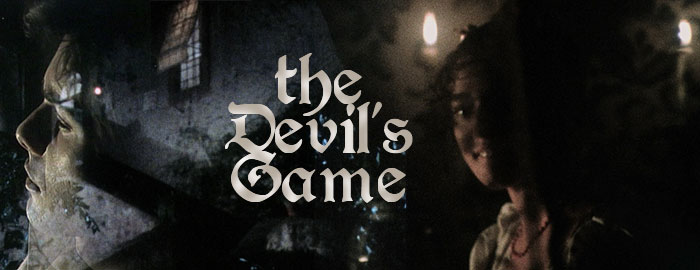
Color, 1981, 445 mins.
Severin Films (Blu-ray) (US R0 HD)
Despite the long-running international love for Italian horror made for the big screen, there's never really been much exposure for its small screen counterparts made from the '60s through the '80s. RAI in particular churned out some impressive genre content over the years that's impossible to see now outside of Italian DVD releases (which aren't English friendly), such as the incredible prog-rock-flavored 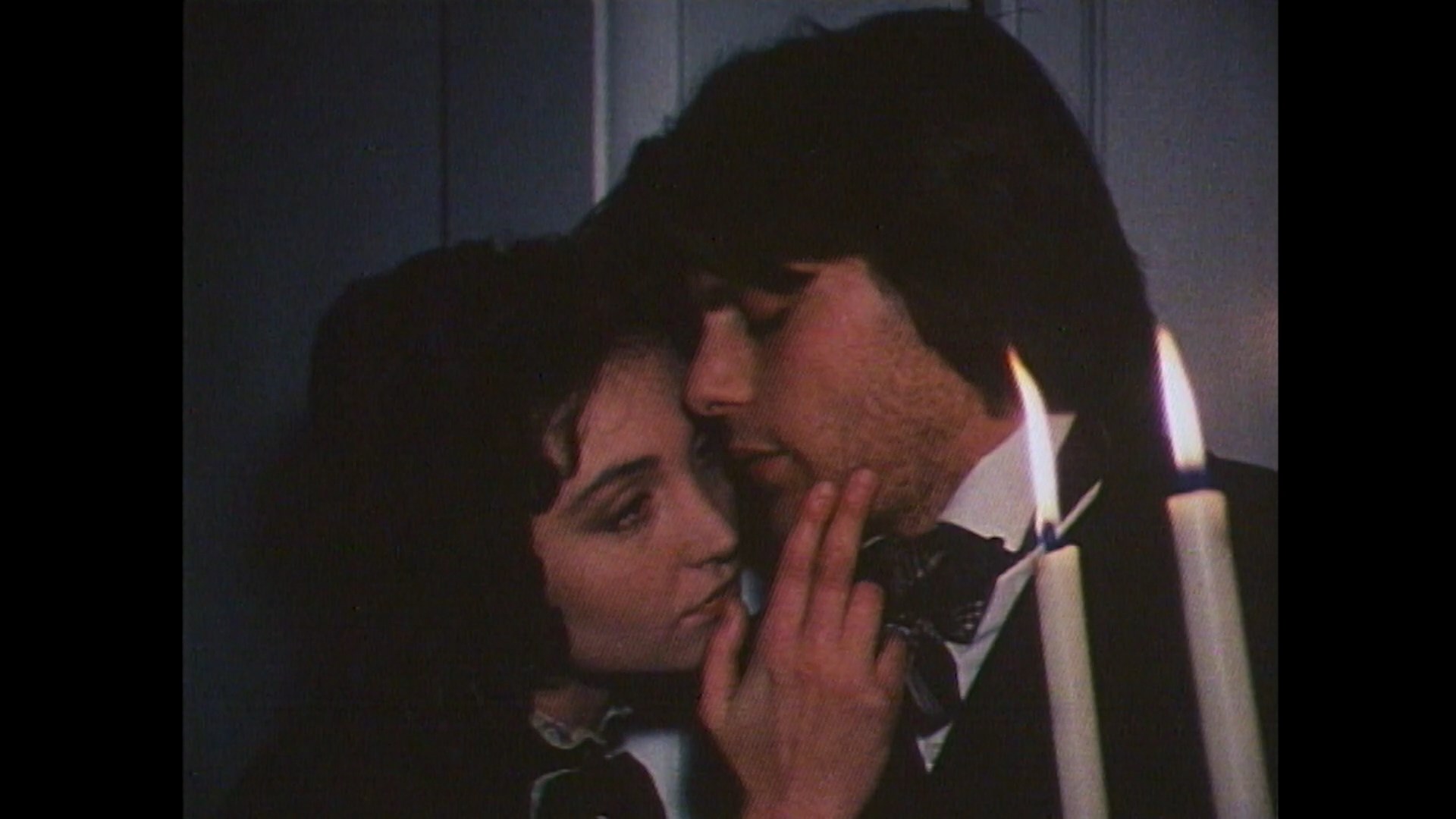 Edgar Allan Poe mash-up Racconti fantastici, a twist on a horror perennial with Jekyll, and the wonderfully atmospheric Ho incontrato un'ombra (which even
Edgar Allan Poe mash-up Racconti fantastici, a twist on a horror perennial with Jekyll, and the wonderfully atmospheric Ho incontrato un'ombra (which even 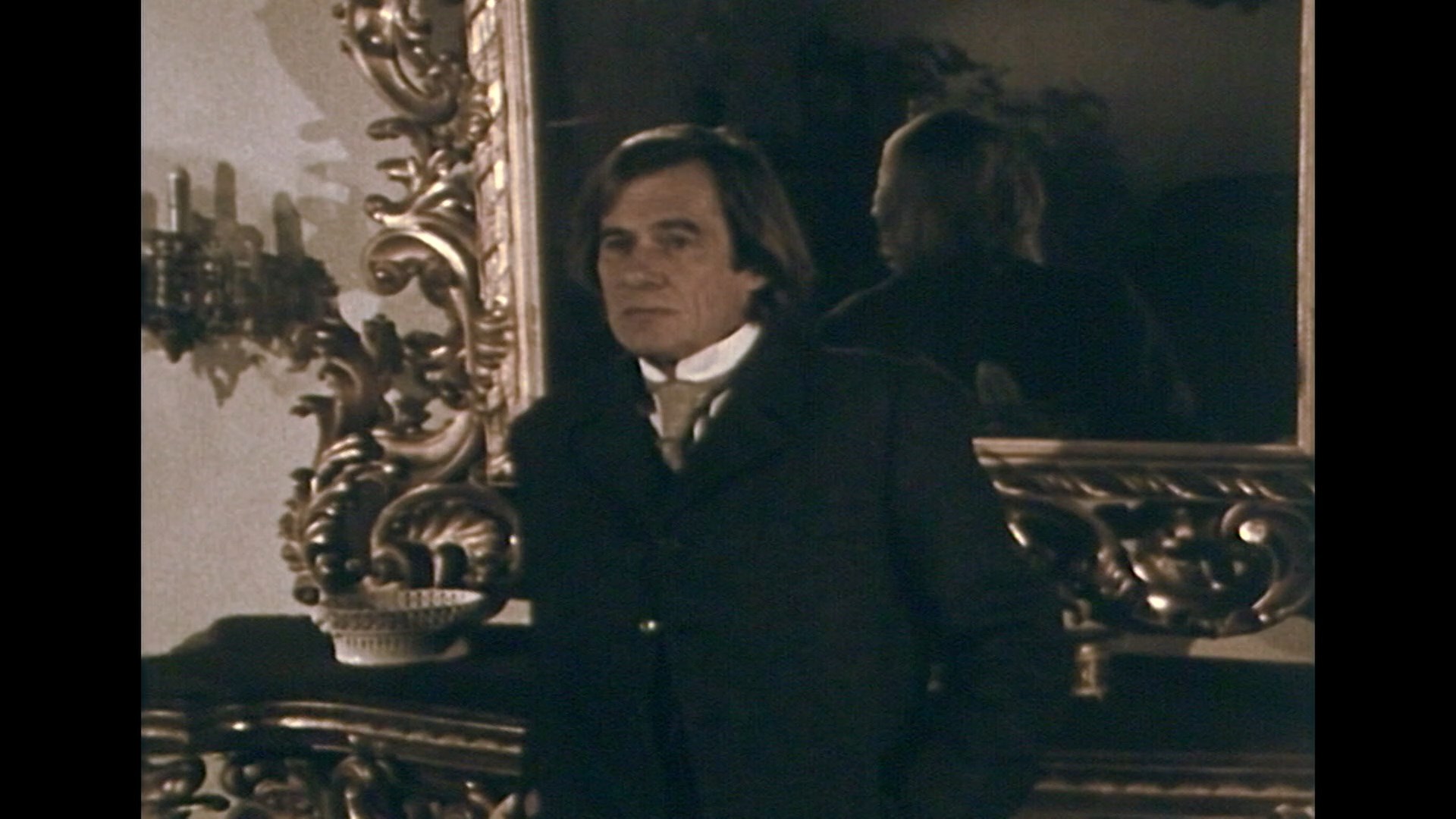 spawned a hit single with its music theme). One of the more enigmatic series in this vein is I giochi del diavolo, a six-part miniseries billed as "fantastic stories from the 1800s" and best known now for providing the final directorial credit for the legendary Mario Bava. Never released on Italian home video, the series created by RAI producer Roberta Carlotto has been given a two-disc Blu-ray release in the U.S. from Severin Films, marking the first time it's been legally available in an English-friendly edition of any kind. Now entitled The Devil's Game (though The Devil's Games would be the meaning of the original title), it shouldn't be approached as a horror show but more of a set of dreamy supernatural art films with luxurious period trappings. There's also an impressive roster of talent in front of and behind the camera for several of these, which will make it a must for any self-respecting Italian genre fan.
spawned a hit single with its music theme). One of the more enigmatic series in this vein is I giochi del diavolo, a six-part miniseries billed as "fantastic stories from the 1800s" and best known now for providing the final directorial credit for the legendary Mario Bava. Never released on Italian home video, the series created by RAI producer Roberta Carlotto has been given a two-disc Blu-ray release in the U.S. from Severin Films, marking the first time it's been legally available in an English-friendly edition of any kind. Now entitled The Devil's Game (though The Devil's Games would be the meaning of the original title), it shouldn't be approached as a horror show but more of a set of dreamy supernatural art films with luxurious period trappings. There's also an impressive roster of talent in front of and behind the camera for several of these, which will make it a must for any self-respecting Italian genre fan.
The first episode, "L'uomo della sabbia" ("The Sandman") (79m55s), comes from none other than cinematic madman Giulio Questi (Death Laid an Egg, Django, Kill... If You Live, Shoot!), based on a story by E.T.A. Hoffman (The Nutcracker) and featuring a score by the great Luis Bacalov. Best known as the ill-fated Proculus in Caligula and star of the popular Italian TV production Il Fauno di marmo, Donato Placido stars as Nathaniel, who brings his sister, Clara (Francesca Muzio), and her fiance, Lotario (Saverio Vallone), to the childhood home where his father was murdered 15 years ago. He's haunted my memories of the Sandman, a macabre nocturnal visitor who plucks out the eyes of sleeping children. From there, the trio's lives take several twists and turns with Nathaniel possibly slipping into madness as he believes the mysterious Coppelius (Mario Feliciani) holds the secret to the family tragedy. Stylish and atmospheric, it's a good starting point for the series, even with a somewhat padded running time. This entry was shot on 16mm film but 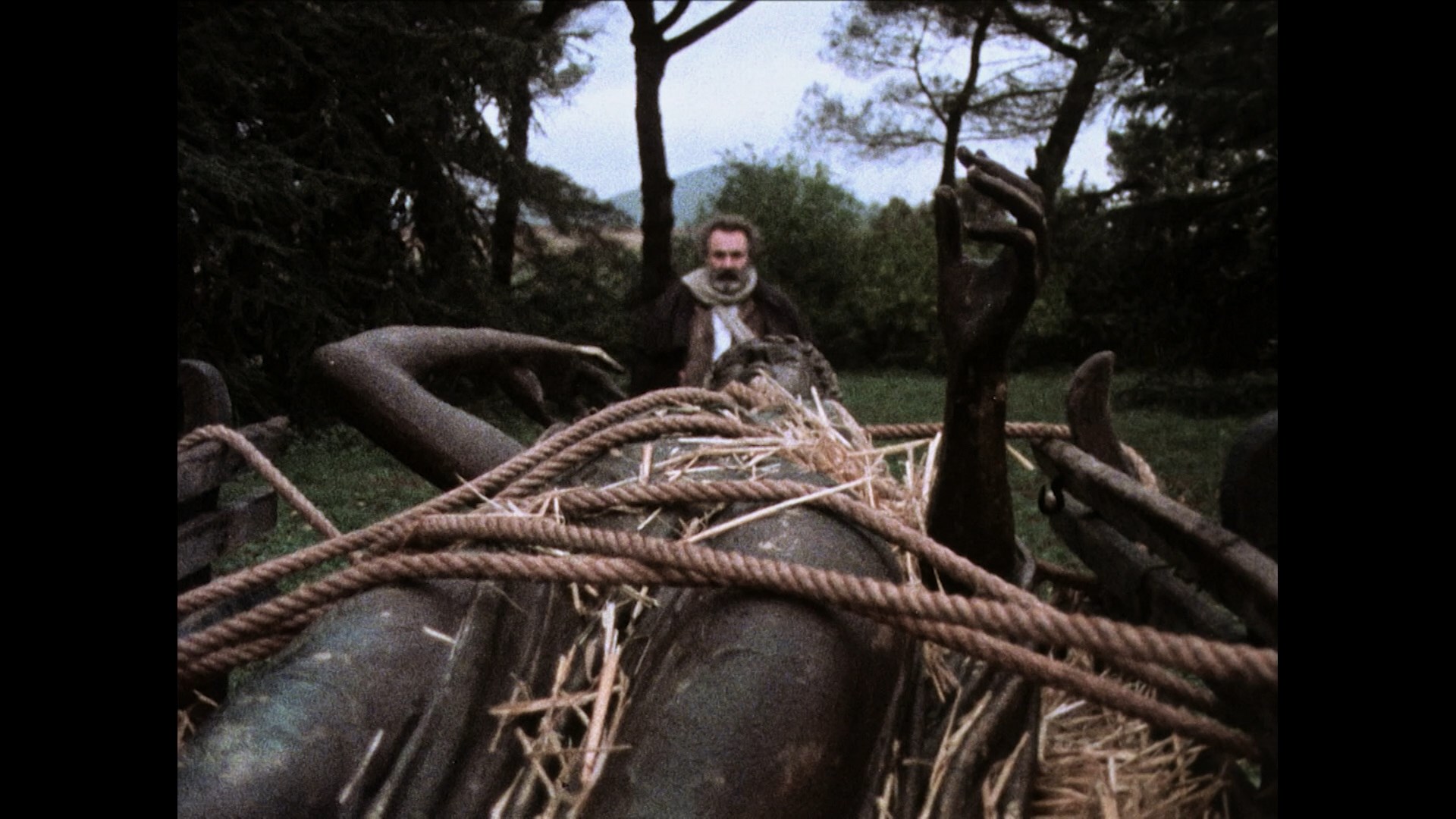 only
only 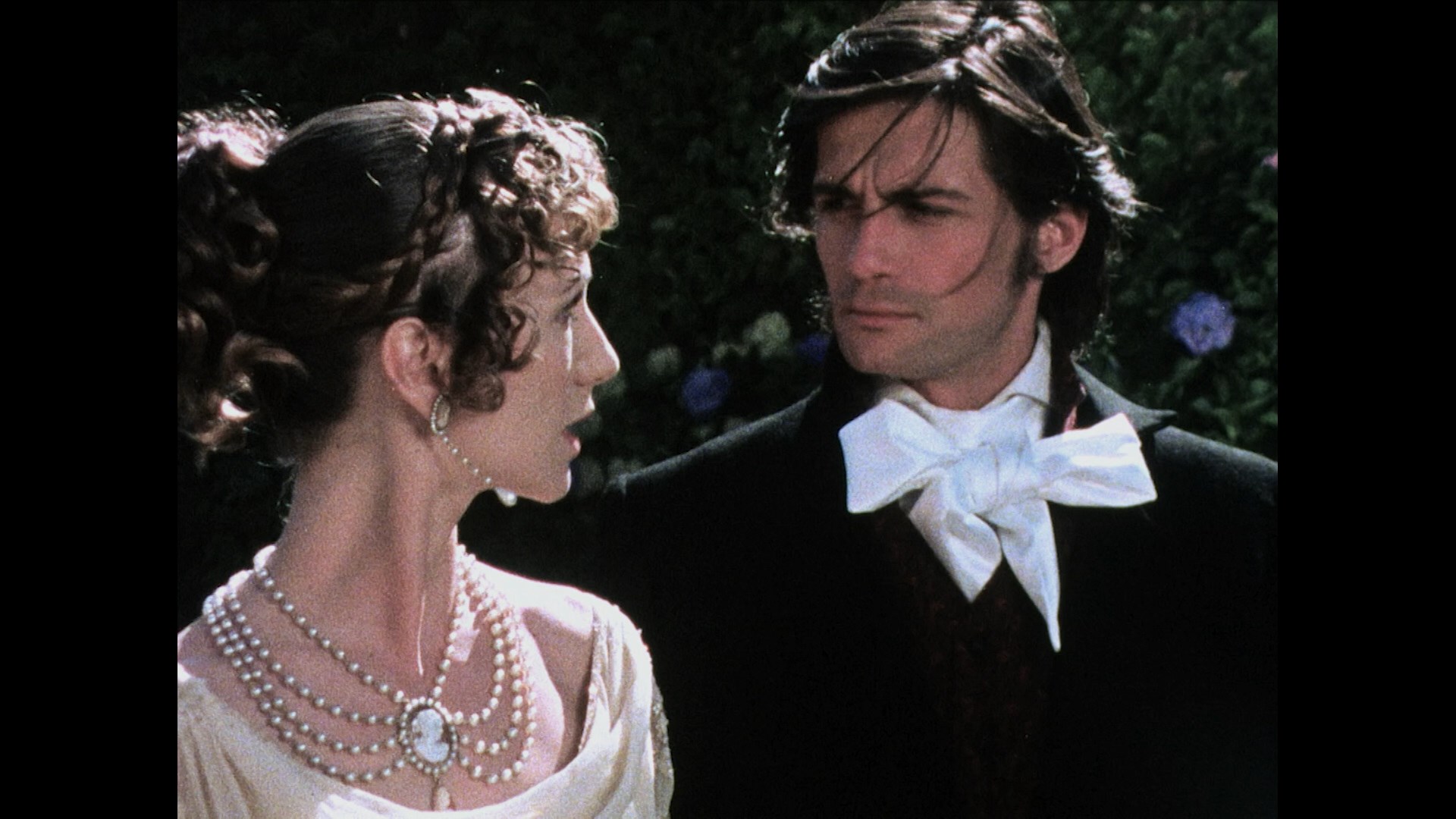 exists today as a standard definition tape master, which provides the source here and still looks okay apart from the occasional analog glitch baked into the source.
exists today as a standard definition tape master, which provides the source here and still looks okay apart from the occasional analog glitch baked into the source.
Next is the big draw of the set, "La Venere d'Ille" ("The Venus of Ille") (63m26s), co-directed by Mario Bava and Lamberto Bava just after the release of the latter's official debut feature, Macabre. Based on a story by Prosper Mérimée, it involves an antiquities specialist, Matthew (The Psychic's Marc Porel), summoned to the estate of the wealthy Mr. de Peyrehorade (Fausto Di Bella) to assess an artifact found on his grounds: a striking statue of the goddess Venus. Rumors of a curse surround the statue with children daring each other to touch it, and meanwhile the son of the manor, Alphonse, is engaged to marry Clara (Daria Nicolodi, fresh off Bava's Shock and star of a prior RAI chilling classic, 1975's Ritratto di donna velata), who reminds Matthew of the uncanny statue when he tries to draw it. When Alphonse temporarily places his wedding ring on the statue, the stage is set for the artifact to reveal its true nature. Rightly regarded as the series' finest achievement, this is an elegant and haunting chamber piece that serves as a suitable swan song for its beloved creator as well as a solid contribution from his son. This is the only episode that still exists on film thanks to a recently discovered 16mm print, and it looks the best of the lot with a fine HD scan bringing out a lot more detail than we've had before. Video Watchdog's Tim Lucas provides another excellent audio commentary laying out the production of the film (which was shot in 1979, with the series belatedly airing in 1981 well after Bava Sr.'s death). He also offers comparisons to the source story and has plenty to say about the collaborative process between its two directors. In "Venus in Love" (21m14s), Lamberto Bava looks back at the film, his only RAI project, including thoughts on what he directed versus how his father might have approached it. He also explains how the very short original story had to be expanded with other elements to bring it up to its current length while maintaining the spirit of the author. Finally in "Nemo Propheta in Patria" (12m56s), cinematographer Nino Celeste chats about the process of working with two directors with very different degrees of experience, as well as the creative choices made to create the right mood for the production.
The third episode and last on the first Blu-ray is "La presenza perfetta" ("The Perfect Presence") (78m50s), directed by Piero Nelli with a score by Piero Piccioni. Based on Henry James' "Sir Edmund Ore," it concerns the eerie experience of upper class, pipe-smoking Henry (William Berger, Five Dolls for an August Moon) when he becomes entangled in the lives of Annie Marden (Rada Rassimov, The Cat o' Nine Tails) and her daughter, Charlotte (Emenuela Barattolo), who seem to be haunted by an apparition from the mother's past. This one is very low key and chatty, but the solid cast and sumptuous production design make it a classy little ghost story on the non-menacing side. Also shot on film, this is taken from the surviving SD master from RAI and looks acceptable for what it is.
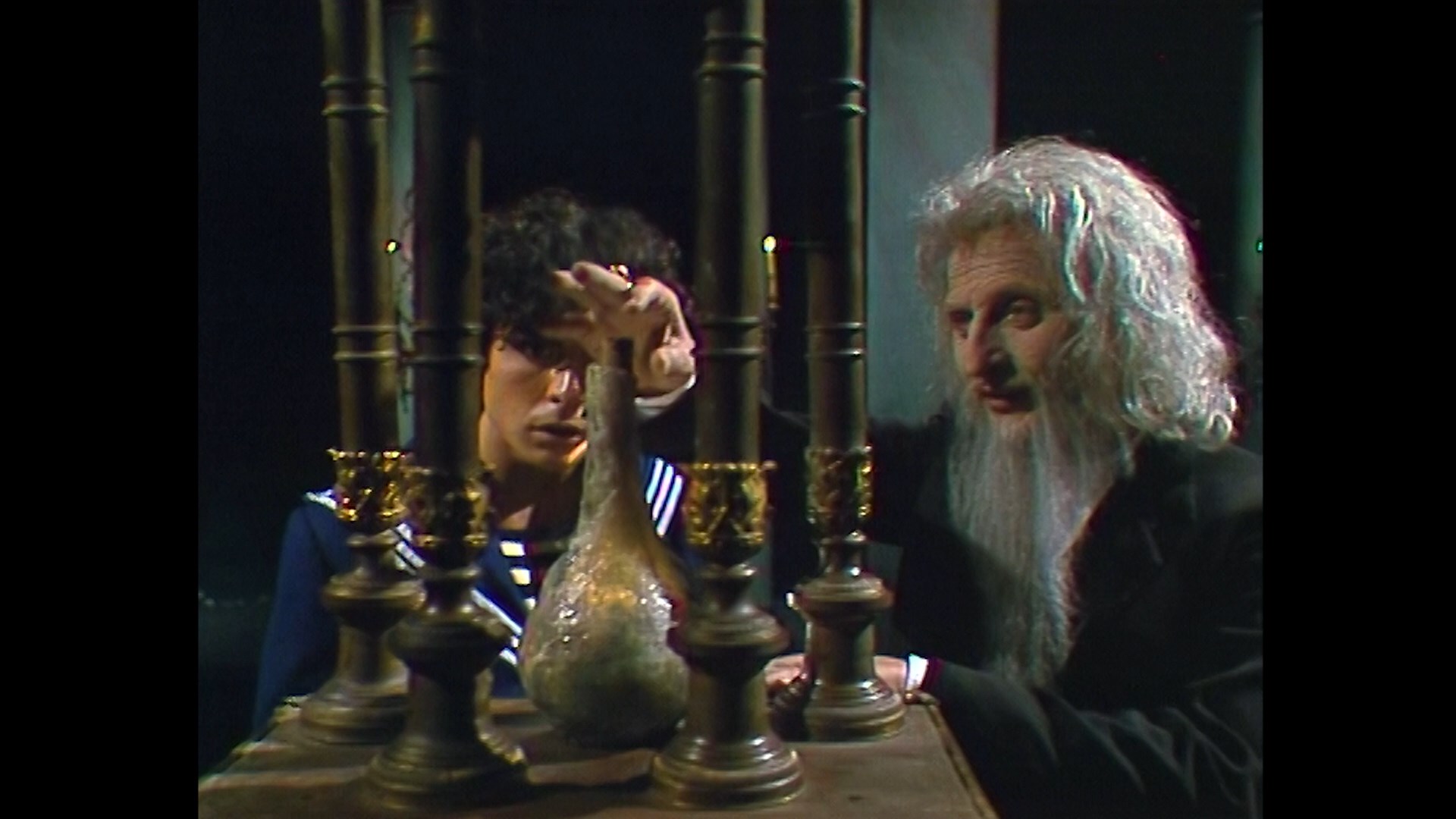 Disc two features the three remaining episodes, all of which were shot on standard definition video instead of film and definitely look it. Directed by Marcello Aliprandi (A Whisper in the Dark) with music by Pino Donaggio,
Disc two features the three remaining episodes, all of which were shot on standard definition video instead of film and definitely look it. Directed by Marcello Aliprandi (A Whisper in the Dark) with music by Pino Donaggio, 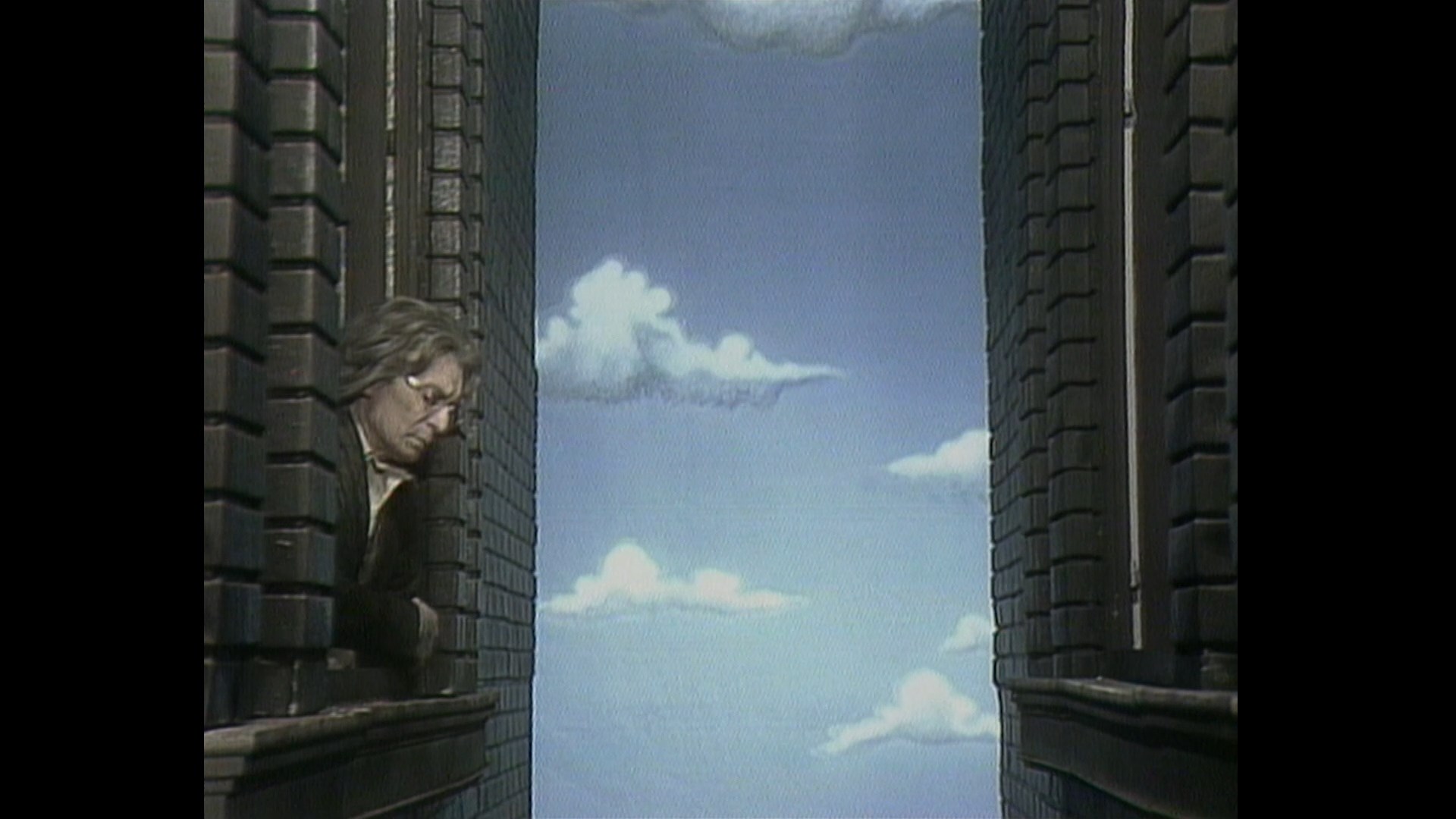 "La mano indemoniata" ("The Possessed Hand") (77m43s) is essentially a remake of the magnificent 1943 French horror film La main du diable (Carnival of Sinners) about a mysterious man showing off a ghastly, seemingly sentient severed hand to a group of guests at an inn during a snowstorm. Through flashbacks we learned the story of the diabolical limb and its origins with a Mephistopholean carnival barker played by the fantastic Gabriele Ferzetti (who makes this episode worth a look all by himself). While the earlier episodes were all shot in scenic locations with convincing period interiors, this one shifts gears for the rest of the stories by being obviously stage-bound with more minimal, stylized sets. That aesthetic goes into overdrive with "Il diavolo nella bottiglia" ("The Bottle Imp") (88m2s), directed by Tomaso Sherman and based on a shortly story by Robert Louis Stevenson. In Samoa, Stevenson (Mario Santella) relates the story of Keawe (Stefano Sabelli), manages to acquire a seemingly unbreakable bottle from an elderly rich gentleman who informs him that it contains an imp capable of granting his dearest wishes. However, the owner will be damned for eternity if he dies while the bottle is still in his possession. Obviously inspired by Powell and Pressburger films (especially The Tales of Hoffman), this is very theatrically staged and often feels more like a ballet with the camera moving back and forth between the stylized action and the narrator. Finally "Il sogno dell'altro" ("The Dream of Another") (59m33s), directed by Giovanna Gagliardo and featuring music by Stelvio Cipriani, is an adaptation of H.G. Wells' "The Story of the Late Mr. Elvesham." Here we have the saga of medical student Edward Eden (Stefano Madia), who is approached by the aging and wealthy Albert Elvesham (José Quaglio) in search of the perfect heir. Of course, that arrangement comes with a very big hitch that turns into an metaphysical nightmare. Again this one is shot on very spare sets, often shrouded in darkness or with a Magritte-style cloud backdrop that gives it a weird, dreamlike feeling throughout. Since these will all likely best first-time viewings for the vast majority, opinions will likely vary about the merits of each episode -- but each one is certainly worth checking out to see an intriguing concept that would never get off the ground on Italian TV today.
"La mano indemoniata" ("The Possessed Hand") (77m43s) is essentially a remake of the magnificent 1943 French horror film La main du diable (Carnival of Sinners) about a mysterious man showing off a ghastly, seemingly sentient severed hand to a group of guests at an inn during a snowstorm. Through flashbacks we learned the story of the diabolical limb and its origins with a Mephistopholean carnival barker played by the fantastic Gabriele Ferzetti (who makes this episode worth a look all by himself). While the earlier episodes were all shot in scenic locations with convincing period interiors, this one shifts gears for the rest of the stories by being obviously stage-bound with more minimal, stylized sets. That aesthetic goes into overdrive with "Il diavolo nella bottiglia" ("The Bottle Imp") (88m2s), directed by Tomaso Sherman and based on a shortly story by Robert Louis Stevenson. In Samoa, Stevenson (Mario Santella) relates the story of Keawe (Stefano Sabelli), manages to acquire a seemingly unbreakable bottle from an elderly rich gentleman who informs him that it contains an imp capable of granting his dearest wishes. However, the owner will be damned for eternity if he dies while the bottle is still in his possession. Obviously inspired by Powell and Pressburger films (especially The Tales of Hoffman), this is very theatrically staged and often feels more like a ballet with the camera moving back and forth between the stylized action and the narrator. Finally "Il sogno dell'altro" ("The Dream of Another") (59m33s), directed by Giovanna Gagliardo and featuring music by Stelvio Cipriani, is an adaptation of H.G. Wells' "The Story of the Late Mr. Elvesham." Here we have the saga of medical student Edward Eden (Stefano Madia), who is approached by the aging and wealthy Albert Elvesham (José Quaglio) in search of the perfect heir. Of course, that arrangement comes with a very big hitch that turns into an metaphysical nightmare. Again this one is shot on very spare sets, often shrouded in darkness or with a Magritte-style cloud backdrop that gives it a weird, dreamlike feeling throughout. Since these will all likely best first-time viewings for the vast majority, opinions will likely vary about the merits of each episode -- but each one is certainly worth checking out to see an intriguing concept that would never get off the ground on Italian TV today.
Reviewed on November 24, 2022.





 Edgar Allan Poe mash-up Racconti fantastici, a twist on a horror perennial with Jekyll, and the wonderfully atmospheric Ho incontrato un'ombra (which even
Edgar Allan Poe mash-up Racconti fantastici, a twist on a horror perennial with Jekyll, and the wonderfully atmospheric Ho incontrato un'ombra (which even  spawned a hit single with its music theme). One of the more enigmatic series in this vein is I giochi del diavolo, a six-part miniseries billed as "fantastic stories from the 1800s" and best known now for providing the final directorial credit for the legendary Mario Bava. Never released on Italian home video, the series created by RAI producer Roberta Carlotto has been given a two-disc Blu-ray release in the U.S. from Severin Films, marking the first time it's been legally available in an English-friendly edition of any kind. Now entitled The Devil's Game (though The Devil's Games would be the meaning of the original title), it shouldn't be approached as a horror show but more of a set of dreamy supernatural art films with luxurious period trappings. There's also an impressive roster of talent in front of and behind the camera for several of these, which will make it a must for any self-respecting Italian genre fan.
spawned a hit single with its music theme). One of the more enigmatic series in this vein is I giochi del diavolo, a six-part miniseries billed as "fantastic stories from the 1800s" and best known now for providing the final directorial credit for the legendary Mario Bava. Never released on Italian home video, the series created by RAI producer Roberta Carlotto has been given a two-disc Blu-ray release in the U.S. from Severin Films, marking the first time it's been legally available in an English-friendly edition of any kind. Now entitled The Devil's Game (though The Devil's Games would be the meaning of the original title), it shouldn't be approached as a horror show but more of a set of dreamy supernatural art films with luxurious period trappings. There's also an impressive roster of talent in front of and behind the camera for several of these, which will make it a must for any self-respecting Italian genre fan.  only
only  exists today as a standard definition tape master, which provides the source here and still looks okay apart from the occasional analog glitch baked into the source.
exists today as a standard definition tape master, which provides the source here and still looks okay apart from the occasional analog glitch baked into the source. Disc two features the three remaining episodes, all of which were shot on standard definition video instead of film and definitely look it. Directed by Marcello Aliprandi (A Whisper in the Dark) with music by Pino Donaggio,
Disc two features the three remaining episodes, all of which were shot on standard definition video instead of film and definitely look it. Directed by Marcello Aliprandi (A Whisper in the Dark) with music by Pino Donaggio,  "La mano indemoniata" ("The Possessed Hand") (77m43s) is essentially a remake of the magnificent 1943 French horror film La main du diable (Carnival of Sinners) about a mysterious man showing off a ghastly, seemingly sentient severed hand to a group of guests at an inn during a snowstorm. Through flashbacks we learned the story of the diabolical limb and its origins with a Mephistopholean carnival barker played by the fantastic Gabriele Ferzetti (who makes this episode worth a look all by himself). While the earlier episodes were all shot in scenic locations with convincing period interiors, this one shifts gears for the rest of the stories by being obviously stage-bound with more minimal, stylized sets. That aesthetic goes into overdrive with "Il diavolo nella bottiglia" ("The Bottle Imp") (88m2s), directed by Tomaso Sherman and based on a shortly story by Robert Louis Stevenson. In Samoa, Stevenson (Mario Santella) relates the story of Keawe (Stefano Sabelli), manages to acquire a seemingly unbreakable bottle from an elderly rich gentleman who informs him that it contains an imp capable of granting his dearest wishes. However, the owner will be damned for eternity if he dies while the bottle is still in his possession. Obviously inspired by Powell and Pressburger films (especially The Tales of Hoffman), this is very theatrically staged and often feels more like a ballet with the camera moving back and forth between the stylized action and the narrator. Finally "Il sogno dell'altro" ("The Dream of Another") (59m33s), directed by Giovanna Gagliardo and featuring music by Stelvio Cipriani, is an adaptation of H.G. Wells' "The Story of the Late Mr. Elvesham." Here we have the saga of medical student Edward Eden (Stefano Madia), who is approached by the aging and wealthy Albert Elvesham (José Quaglio) in search of the perfect heir. Of course, that arrangement comes with a very big hitch that turns into an metaphysical nightmare. Again this one is shot on very spare sets, often shrouded in darkness or with a Magritte-style cloud backdrop that gives it a weird, dreamlike feeling throughout. Since these will all likely best first-time viewings for the vast majority, opinions will likely vary about the merits of each episode -- but each one is certainly worth checking out to see an intriguing concept that would never get off the ground on Italian TV today.
"La mano indemoniata" ("The Possessed Hand") (77m43s) is essentially a remake of the magnificent 1943 French horror film La main du diable (Carnival of Sinners) about a mysterious man showing off a ghastly, seemingly sentient severed hand to a group of guests at an inn during a snowstorm. Through flashbacks we learned the story of the diabolical limb and its origins with a Mephistopholean carnival barker played by the fantastic Gabriele Ferzetti (who makes this episode worth a look all by himself). While the earlier episodes were all shot in scenic locations with convincing period interiors, this one shifts gears for the rest of the stories by being obviously stage-bound with more minimal, stylized sets. That aesthetic goes into overdrive with "Il diavolo nella bottiglia" ("The Bottle Imp") (88m2s), directed by Tomaso Sherman and based on a shortly story by Robert Louis Stevenson. In Samoa, Stevenson (Mario Santella) relates the story of Keawe (Stefano Sabelli), manages to acquire a seemingly unbreakable bottle from an elderly rich gentleman who informs him that it contains an imp capable of granting his dearest wishes. However, the owner will be damned for eternity if he dies while the bottle is still in his possession. Obviously inspired by Powell and Pressburger films (especially The Tales of Hoffman), this is very theatrically staged and often feels more like a ballet with the camera moving back and forth between the stylized action and the narrator. Finally "Il sogno dell'altro" ("The Dream of Another") (59m33s), directed by Giovanna Gagliardo and featuring music by Stelvio Cipriani, is an adaptation of H.G. Wells' "The Story of the Late Mr. Elvesham." Here we have the saga of medical student Edward Eden (Stefano Madia), who is approached by the aging and wealthy Albert Elvesham (José Quaglio) in search of the perfect heir. Of course, that arrangement comes with a very big hitch that turns into an metaphysical nightmare. Again this one is shot on very spare sets, often shrouded in darkness or with a Magritte-style cloud backdrop that gives it a weird, dreamlike feeling throughout. Since these will all likely best first-time viewings for the vast majority, opinions will likely vary about the merits of each episode -- but each one is certainly worth checking out to see an intriguing concept that would never get off the ground on Italian TV today. ![]()